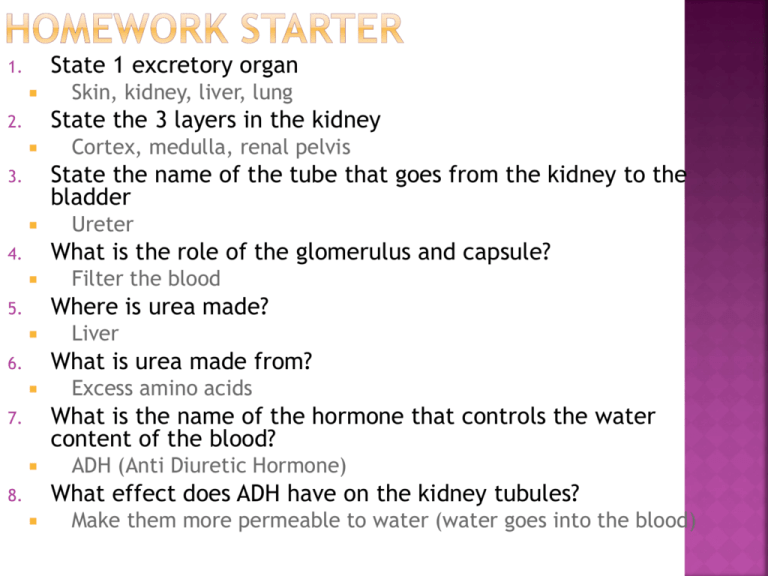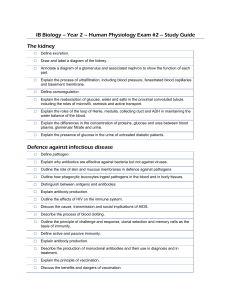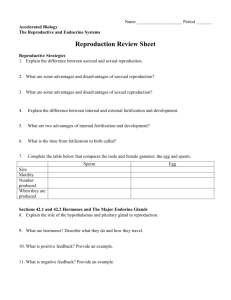
State 1 excretory organ
1.
Skin, kidney, liver, lung
State the 3 layers in the kidney
2.
Cortex, medulla, renal pelvis
State the name of the tube that goes from the kidney to the
bladder
3.
Ureter
What is the role of the glomerulus and capsule?
4.
Filter the blood
Where is urea made?
5.
Liver
What is urea made from?
6.
Excess amino acids
What is the name of the hormone that controls the water
content of the blood?
7.
ADH (Anti Diuretic Hormone)
What effect does ADH have on the kidney tubules?
8.
Make them more permeable to water (water goes into the blood)
Explain the detailed
functioning of the
kidney (Grade A)
Important in
reabsorption of
water (under
hormonal control)
Correct label and state the function of each part of a nephron (kidney
tubule)
Blood enters the kidney in the
renal artery
________________________
The blood is filtered because it is
under _________________
high
pressure.
________________________
large
molecules stay in the blood
Small molecules pass through the
filter.
Useful molecules are
reabsorbed
________________
Purified blood leaves the kidney in
the
Waste materials leave the kidney in
a tube called the
________________________
________________________
ureter
renal vein
Patients who have kidney failure
can’t filter their blood properly –
but a dialysis machine can do it
for them.
How often does dialysis need to
be done?
For upto 10hrs every few days
Why is the membrane semipermeable?
To allow waste substances to pass
through e.g. urea
Why does dialysis fluid have the
same concentration of salts and
glucose as blood plasma?
So they aren’t removed from the
blood
Explain the principle
of a dialysis
machine (Grade A)
1.
2.
3.
4.
5.
6.
Where in the body is urea produced?
Liver
What is getting rid of undigested food from the body
called?
Egestion
What is the function of the glomerulus?
Ultrafiltration
What process is used to reabsorb sodium?
Active transport
Why is glucose reabsorbed by the body?
Needed for respiration
What does the presence of glucose in the urine
suggest?
Diabetes
To understand the
organs of excretion,
specifically the
kidney
Learning objectives
State and locate the
main excretory organs
(E)
Describe the gross
structure of the kidney
(Grade C)
Explain the detailed
functioning of the
kidney (Grade A)
Explain the principle of
a dialysis machine
(Grade A)
Success criteria
State 1 excretory organ
1.
Skin, kidney, liver, lung
State the 3 layers in the kidney
2.
Cortex, medulla, renal pelvis
State the name of the tube that goes from the kidney to the
bladder
3.
Ureter
What is the role of the glomerulus and capsule?
4.
Filter the blood
Where is urea made?
5.
Liver
What is urea made from?
6.
Excess amino acids
What is the name of the hormone that controls the water
content of the blood?
7.
ADH (Anti Diuretic Hormone)
What effect does ADH have on the kidney tubules?
8.
Make them more permeable to water (water goes into the blood)
Describe
the main stages of the menstrual
cycle (Grade E)
Describe the role of hormones in the
menstrual cycle (Grade C)
Explain how negative feedback is used in
control of the menstrual cycle (Grade A)
In
pairs label the reproductive systems
MALE
SYSTEM
Bladder
Glands
Sperm duct
Urethra
Penis
Coiled tube
Scrotum
Testis
(pl testes)
© Teachable and Jan Stevens. Some rights reserved. http://teachable.net/res.asp?r=2595
Erectile
tissue
Foreskin
Stores urine
Transfers sperm to
the woman
A sac of skin that
hold the testes
outside the body
to keep them cool
Carries sperm and
urine out of the body
Where sperm are
stored
Fills with blood to
stiffen the penis
© Teachable and Jan Stevens. Some rights reserved. http://teachable.net/res.asp?r=2595
Make liquid to feed and
activate the sperm
Where the sperm
are made
Squeezes the sperm along
OVIDUCT or
FALLOPIAN TUBE
UTERUS or WOMB
SOFT
LINING
OVARY
MUSCLE LAYER
CERVIX
VAGINA
FEMALE
SYSTEM
© Teachable and Jan Stevens. Some rights reserved. http://teachable.net/res.asp?r=2595
Rich in blood vessels to
supply the baby with food
and oxygen
Used to push the
baby out during
birth.
Narrow opening
through which the
baby must be pushed
out during birth.
Where the eggs are
made
Lined with hairs (cilia)
that beat and carry the
egg along.
Where the sperm are
released by the
man’s penis.
Where the baby grows
© Teachable and Jan Stevens. Some rights reserved. http://teachable.net/res.asp?r=2595
Menstrual
Cycle
http://www.bbc.co.uk/learningzone/clips/thechanges-that-occur-during-the-menstrualcycle/1847.html
Ovulation
http://www.bbc.co.uk/learningzone/clips/ovula
tion/1845.html
In
pairs decide on the main stages of the
menstrual cycle
Menstruation
Uterus lining breaks down (a period)
Thickening
of uterus lining
Ovulation
Egg released by ovary
Oestrogen
Repairs uterus wall
Progesterone
Maintains uterus wall
FSH
Released by pituitary gland
Stimulates egg development
LH
(follicle stimulating hormone)
(lutenising hormone)
Released by pituitary gland
Controls ovulation
Progesterone
inhibits FSH
No more eggs are matured
Complete
worksheet B5g1 part 2&3
2.
A)
B)
name of hormone
hormone A
Oestrogen
hormone B
Progesterone
hormone A
one function of
hormone
Build lining
Maintain lining
hormone B
2.
3.
C i) Stimulate the development of the egg
C ii) Cause ovulation (egg release)
A) Ovary
B) Progesterone inhibits FSH
C)
pituitary gland
Oestrogen
inhibits FSH
follicle stimulating hormone luteinising hormone
(LH)
(FSH)
negative feedback
ovary
on FSH release
stimulates
stimulates egg
progesterone
development
release
What causes the uterus lining to break down?
1.
No fertilised egg
Where are the hormones oestrogen and progesterone
made?
2.
Ovaries
From where are the eggs released?
3.
Ovaries
Which hormone stimulates egg release
4.
LH
Which two hormones are produced by the pituitary
gland?
5.
LH and FSH
What does follicle stimulating hormone do?
6.
Stimulate egg development
Which two hormones are involved in the uterus lining?
7.
Progesterone and Oestrogen
What is ovulation?
8.
Egg release
What hormones are inhibited by progesterone?
9.
LH and FSH









